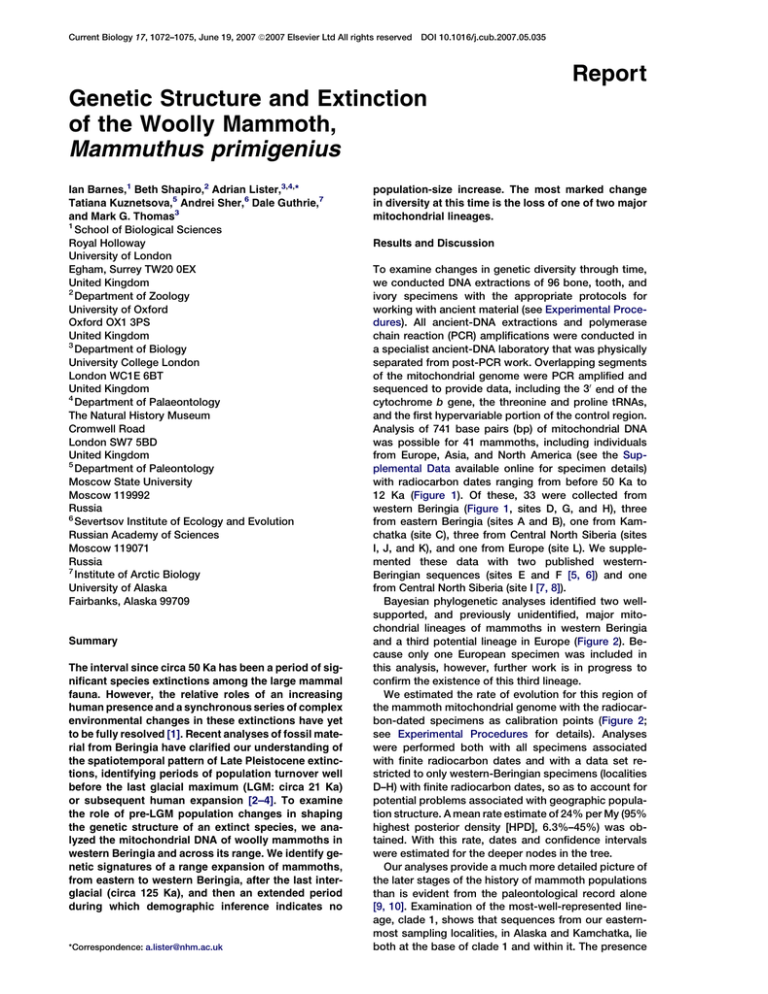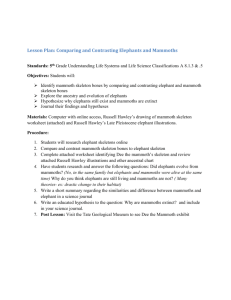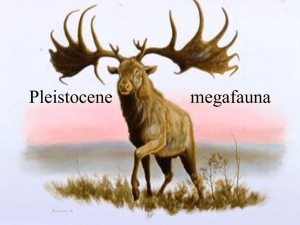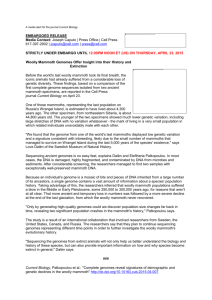
Current Biology 17, 1072–1075, June 19, 2007 ª2007 Elsevier Ltd All rights reserved
DOI 10.1016/j.cub.2007.05.035
Report
Genetic Structure and Extinction
of the Woolly Mammoth,
Mammuthus primigenius
Ian Barnes,1 Beth Shapiro,2 Adrian Lister,3,4,*
Tatiana Kuznetsova,5 Andrei Sher,6 Dale Guthrie,7
and Mark G. Thomas3
1
School of Biological Sciences
Royal Holloway
University of London
Egham, Surrey TW20 0EX
United Kingdom
2
Department of Zoology
University of Oxford
Oxford OX1 3PS
United Kingdom
3
Department of Biology
University College London
London WC1E 6BT
United Kingdom
4
Department of Palaeontology
The Natural History Museum
Cromwell Road
London SW7 5BD
United Kingdom
5
Department of Paleontology
Moscow State University
Moscow 119992
Russia
6
Severtsov Institute of Ecology and Evolution
Russian Academy of Sciences
Moscow 119071
Russia
7
Institute of Arctic Biology
University of Alaska
Fairbanks, Alaska 99709
Summary
The interval since circa 50 Ka has been a period of significant species extinctions among the large mammal
fauna. However, the relative roles of an increasing
human presence and a synchronous series of complex
environmental changes in these extinctions have yet
to be fully resolved [1]. Recent analyses of fossil material from Beringia have clarified our understanding of
the spatiotemporal pattern of Late Pleistocene extinctions, identifying periods of population turnover well
before the last glacial maximum (LGM: circa 21 Ka)
or subsequent human expansion [2–4]. To examine
the role of pre-LGM population changes in shaping
the genetic structure of an extinct species, we analyzed the mitochondrial DNA of woolly mammoths in
western Beringia and across its range. We identify genetic signatures of a range expansion of mammoths,
from eastern to western Beringia, after the last interglacial (circa 125 Ka), and then an extended period
during which demographic inference indicates no
*Correspondence: a.lister@nhm.ac.uk
population-size increase. The most marked change
in diversity at this time is the loss of one of two major
mitochondrial lineages.
Results and Discussion
To examine changes in genetic diversity through time,
we conducted DNA extractions of 96 bone, tooth, and
ivory specimens with the appropriate protocols for
working with ancient material (see Experimental Procedures). All ancient-DNA extractions and polymerase
chain reaction (PCR) amplifications were conducted in
a specialist ancient-DNA laboratory that was physically
separated from post-PCR work. Overlapping segments
of the mitochondrial genome were PCR amplified and
sequenced to provide data, including the 30 end of the
cytochrome b gene, the threonine and proline tRNAs,
and the first hypervariable portion of the control region.
Analysis of 741 base pairs (bp) of mitochondrial DNA
was possible for 41 mammoths, including individuals
from Europe, Asia, and North America (see the Supplemental Data available online for specimen details)
with radiocarbon dates ranging from before 50 Ka to
12 Ka (Figure 1). Of these, 33 were collected from
western Beringia (Figure 1, sites D, G, and H), three
from eastern Beringia (sites A and B), one from Kamchatka (site C), three from Central North Siberia (sites
I, J, and K), and one from Europe (site L). We supplemented these data with two published westernBeringian sequences (sites E and F [5, 6]) and one
from Central North Siberia (site I [7, 8]).
Bayesian phylogenetic analyses identified two wellsupported, and previously unidentified, major mitochondrial lineages of mammoths in western Beringia
and a third potential lineage in Europe (Figure 2). Because only one European specimen was included in
this analysis, however, further work is in progress to
confirm the existence of this third lineage.
We estimated the rate of evolution for this region of
the mammoth mitochondrial genome with the radiocarbon-dated specimens as calibration points (Figure 2;
see Experimental Procedures for details). Analyses
were performed both with all specimens associated
with finite radiocarbon dates and with a data set restricted to only western-Beringian specimens (localities
D–H) with finite radiocarbon dates, so as to account for
potential problems associated with geographic population structure. A mean rate estimate of 24% per My (95%
highest posterior density [HPD], 6.3%–45%) was obtained. With this rate, dates and confidence intervals
were estimated for the deeper nodes in the tree.
Our analyses provide a much more detailed picture of
the later stages of the history of mammoth populations
than is evident from the paleontological record alone
[9, 10]. Examination of the most-well-represented lineage, clade 1, shows that sequences from our easternmost sampling localities, in Alaska and Kamchatka, lie
both at the base of clade 1 and within it. The presence
Mammoth Population, Genetics, and Extinction
1073
Figure 1. A Polar Projection Showing the Locations from which
Samples Were Obtained
The dashed line indicates the approximate extent of Beringia.
of clade 1 sequences from eastern Beringia that root at
both ancestral and more derived nodes and the reduced
diversity observed across Siberia suggest that the origins of this lineage are in the east. A lower bound for
the timing of the western expansion of clade 1, taken
as the time to the most recent common ancestor of
the Siberian component of this clade (Figure S1, node
A), is estimated at 63.4 Ka (HPD 47–94 Ka). This timing
places the migration of mammoths after the last interglacial—marine isotope stage (MIS) 5e. Two factors
would have restricted migration between eastern and
western Beringia until after this time: The interglacial
rise in sea levels would have submerged the Bering
land bridge until at least around 100 Ka [11], and warmer
climatic conditions would have led to northern expansion of boreal forest [12–14], constraining steppe-adapted mammoths to the far north.
After this period of post-MIS 5 western expansion,
clade 1 can be observed across the sampling area,
from Alaska to Central Siberia (Figures 1 and 2). Recovery of clade 2 sequences is restricted to the more heavily
sampled western-Beringian sites (localities G and H).
Interestingly, although both clades are present prior to
the upper limit of radiocarbon dating (circa 50 Ka), only
clade 1 persists until the end of the Pleistocene. Clade
2 is last observed at 43.6 Ka, indicating an at least local
extinction of this lineage around that time.
Although the extinction of clade 2 might be attributed
to selection against individuals with this haplotype, this
seems unlikely. In this scenario, selection would require
either that the clade 1 mitochondrial genome possessed
Figure 2. A Maximum-Likelihood Phylogeny for the 44 Mammoth
Sequences Employed in This Study
Numbers to the left of nodes indicate the degree of support for those
nodes on the basis of posterior probability and bootstrapping (in
brackets). On branch tips, letter codes and colors indicate sample
locations (as in Figure 1), and numbers indicate the point-estimate
radiocarbon date. Full details of sequence analysis and sample
provenance are given in the Experimental Procedures and Supplemental Data.
some fitness advantage over clade 2, a situation rarely
identified in wild populations [15], or that adaptive differences between the two populations had been maintained by reproductive isolation despite their sympatric
distribution over millennia. A much more likely explanation is that clade 1 became fixed within the westernBeringian population by genetic drift under conditions
of zero or negative population growth. An interpretation
of constant population size is further supported by the
regional stability of climate and vegetation during MIS
3 [16] and by Bayesian estimation of population-size
changes for western-Beringian mammoths (Table 1
and Supplemental Data). For these analyses, we used
the 33 finite dated sequences in phylogenetic analyses
assuming two different fixed coalescent models of
population history, (1) constant population size and (2)
Table 1. Exponential Growth Rates Estimated in Strict- and Relaxed-Clock BEAST Analyses of 33 Mammoth Sequences Associated with Finite
Radiocarbon Dates
Mean
95% HPD lower
95% HPD upper
Effective sample size
Strict Clock (HKY+G)
Strict Clock (HKY+I)
Relaxed Clock (HKY+G)
Relaxed Clock (HKY+I)
6.62E-06
26.58E-06
2.23E-05
5267.414
1.48E-06
21.37E-05
1.77E-05
5697.028
3.90E-05
27.20E-06
1.10E-04
312.595
5.71E-05
21.15E-05
1.65E-04
192.951
A growth rate of 0 was included in the posterior distribution of each analysis.
Current Biology
1074
exponential growth or decline, and a more complex
model in which the population history is estimated
from the data across the sampling period (the Bayesian
skyline plot [17]). In all three models, tree topology and
substitution parameters were estimated simultaneously
with the demographic-model parameters.
These analyses indicate a relatively constant population size throughout the time to the common ancestor of
the sampled mammoths. Comparison of the mean (ln)
posterior and mean (ln) coalescent likelihoods reveals
that the data do not support a model of recent growth
or decline. Although the exponential-growth model
does appear to fit the data slightly better than the other
models, the growth rate estimated from this analysis is
extremely low, and in all four of the variants of this model
examined (Table 1), a value of 0 (no growth) is included in
the 95% confidence intervals.
Although the results of all three demographic analyses
indicate a lack of population expansion or decline during
MIS 3 (60–25 Ka), we note that the power of the Bayesian
skyline plot to detect rapid decline and recovery from
our data set of western-Beringian mammoths is weak:
The signal for the loss of clade 2 during this period is
not recovered, most likely because of the small number
and relatively old dates of the two individuals representing this clade. However, because fine-scale sampling
across this potential bottleneck is practically impossible
because of the limits of finite radiocarbon dating, small
and rapid changes in population size are unlikely to be
detected in the genetic data by coalescent-based inference [18]. This might explain the apparent discrepancy
between the estimate of population-size change based
on the frequency of radiocarbon-dated material [16]
and that based on the Bayesian analyses. Importantly,
however, we can reject an MIS 3 population crash or
local extinction of the type observed in bison, brown
bears, and horses [2–4] in favor of an overall trend for
population stability during MIS 3.
Recent research on the extinction of the mammoth
fauna of northern latitudes in the Late Pleistocene and
Holocene (circa12 Ka to the present) has defined dates
and areas of final occurrence for several Holarctic species [3, 10, 19, 20]. These studies have highlighted the
importance of environmental (particularly vegetational)
changes in understanding the extinction process while
also casting doubt on a single, simple explanation for
Late Pleistocene extinctions (see also [1]). AncientDNA analyses have focused on past faunal migration,
replacement, and changes in population size [2, 4],
drawing attention to demographic events occurring
prior to the onset of full-glacial conditions, during MIS
3. The local extinction of brown bears and stilt-legged
horses in Alaska at circa 35 Ka [2, 3] and a decline in
bison population size starting around 30–35 Ka [4, 17]
hint at the importance of early, preglacial events in determining the late-glacial and postglacial status of these
surviving taxa. However, the western-Beringian mammoths, in contrast to the other species so far studied,
do not follow the pattern of complex population-size
change and turnover during MIS 3. This emphasizes
the importance of determining multiple individualspecies histories in understanding the Late Pleistocene
extinctions. We identify two phenomena that would
have resulted in a more gradual loss of genetic diversity
for this population: a founder effect following a post-MIS
5 expansion, and negligible or negative population
growth during MIS 3. The extent to which this sample
is representative of mammoths across their range and
the relationship between demographic history and
extinction remain to be fully determined.
Experimental Procedures
DNA was extracted with the method described in [2], modified by the
collection of bone powder by the use of either a Spex freezer mill or a
20 mm drill bit at very low speed (approximately 60 rpm). Extractions
were conducted in batches of 12 samples with at least one negative
extraction control in each batch, with 100–200 mg of bone powder
used in each extraction and a final extract volume of 30–50 ul.
PCR amplifications were performed in 25 mL reactions with 1 mL of
extract, 1.25 U Platinum Taq Hi-Fidelity and 1X buffer (Invitrogen,
UK), 2 mg/ml bovine serum albumin (BSA), 2 mM MgSO4, 250 mM
of each deoxynucleotide triphosphate (dNTP), and 1 mM of each
primer. PCR thermal-cycling reactions were 94 C for 3 min, 40 cycles of 94 C denaturation for 30 s, annealing at 50 C –55 C (depending on the primer) for 45 s, and extension at 68 C for 45 s. Negative
controls were used in each amplification, and on the rare occasions
(n = 2) that these were positive (i.e., contaminated), the results of that
set of amplifications were rejected. The 741 bp sequence contigs
used in this study were generated with one of three amplification
strategies, depending on the success of preliminary amplifications
(Table S2). The resulting contigs cover the terminal 244 bp of cytochrome b, the complete tRNA-Thr and tRNA-Pro, and the first hypervariable portion of the control region. The overlapping nature of
these PCR strategies results in a substantial degree of sequence
replication for each sample (for strategy 1, 33% of base positions
are replicated in a separate sequence, for strategy 2, 35%, and for
strategy 3, 25%).
Sequencing reactions were conducted with the ABI PRISM Big
Dye v2.0 chemistry and resolved with an ABI 3100 sequencer. A subset of amplifications made on four templates with the primer combination 15393F/15780R were cloned with Invitrogen’s TOPO-TA cloning vector, and individual clones were sequenced to give some
indication of template quality and the possible presence of nuclear
copies. The absence of any clearly identifiable alternative sequence
among these clones, coupled with the absence of any mismatch
when the heavily overlapping primers in our amplification strategies
were used, suggests that nuclear-encoded copies of mitochondrial
sequences (numts) were not recovered. Sequences were found to
be totally consistent between fragments generated by different
primer pairs and replicable between amplifications when the same
primer pairs were used (details available upon request).
Phylogenetic relationships among the 44 mammoths for which
DNA-sequence information was available were estimated with the
phylogenetic-analysis software MrBayes v3.1.2 [21] and PAUP
v4b10 [22]. Substitution models were compared with likelihood-ratio
tests (when nested) and the Akaike Information Criterion. The Hasegawa-Kishino-Yano + gamma + invariant sites (HKY+G+I) model,
which incorporates different rates for transitions and transversions,
rate variation across sites, and a proportion of invariable sites, was
used to generate Bayesian posterior probabilities. Markov-chain
Monte Carlo (MCMC) sampling was performed as implemented in
MrBayes with the default settings (two runs of four chains each)
for 10,000,000 iterations, with the first 10% discarded as burn in.
Mixing and convergence to stationary distributions were investigated with Tracer v1.4 [23]. A maximum likelihood (ML) phylogeny
was estimated with PAUP with the evolutionary model described
above. An initial tree was generated by neighbor joining (NJ), followed by estimation of substitution-model parameters. A full heuristic search was then performed with subtree pruning and regrafting
(SPR)-branch swapping with the parameters fixed to the estimated
values. Parameters were then re-estimated, and the heuristic search
was performed again. To determine support for the nodes, we performed 1000 full-heuristic bootstrap replicates with resampling,
with starting trees generated by NJ and nearest-neighbor interchange (NNI)-branch swapping and with model parameters fixed
to the estimated values.
Mammoth Population, Genetics, and Extinction
1075
To estimate a rate of evolution and dates of divergence between
the clades, we performed both strict-clock and uncorrelated lognormal relaxed-clock analyses [24] as implemented in the software BEAST v1.4 [25] on a subset of the full data set consisting of
33 samples with finite radiocarbon dates. For both the strict- and relaxed-clock analyses, we used the HKY+I and the HKY+G model of
nucleotide substitution, with sequence ages fixed to the mean
uncalibrated radiocarbon date. For each analysis, the demographic
function was estimated under different models (see Results and
Discussion), including the Bayesian skyline plot [17] with five steps.
Posterior distributions of parameters were approximated by MCMC
sampling, with samples drawn every 3000 iterations over a total of
30,000,000 iterations after a discarded burn in of 10%. To check
for consistency among the posterior distributions, we ran each analysis, and the results were combined. Mixing and convergence to the
stationary distribution were evaluated, and the Bayesian skyline plot
was calculated with Tracer v1.4. Posterior estimates for rate and
divergence-date estimates were broadly similar between the analyses, although as expected the 95% HPD was wider when a relaxed
clock was used (Table S3, Supplemental Data). Values reported in
the main text are those from the best-fitting model (relaxed clock,
HKY+I). To estimate the demographic history of the Siberian mammoth population, we performed molecular-clock analyses with the
HKY+I model as above, but we limited the data set to 25 samples
from western Beringia (sites D–H) with finite radiocarbon dates.
Supplemental Data
Experimental Procedures, two figures, and three tables are available
at
http://www.current-biology.com/cgi/content/full/17/12/1072/
DC1/.
Acknowledgments
We thank Tony Stuart and Lembi Loũgas for sample provision, and
Andrew Rambaut for assistance with data analysis. This work was
supported by the United Kingdom Natural Environment Research
Council (I.B.), the Royal Society (B.S.), and the Russian Foundation
for Basic Research (A.S.). T.K. and A.S. thank the Russian-German
Laptev Sea System program for contributing to the collection and
dating of material.
Received: March 20, 2007
Revised: May 10, 2007
Accepted: May 15, 2007
Published online: June 7, 2007
References
1. Barnosky, A., Koch, P., Feranec, R., Wing, S., and Shabel, A.
(2004). Assessing the causes of late Pleistocene extinctions on
the continents. Science 306, 70–75.
2. Barnes, I., Matheus, P., Shapiro, B., Jensen, D., and Cooper, A.
(2002). Dynamics of Pleistocene population extinctions in Beringian brown bears. Science 295, 2267–2270.
3. Guthrie, R.D. (2003). Rapid body size decline in Alaskan Pleistocene horses before extinction. Nature 426, 169–171.
4. Shapiro, B., Drummond, A., Rambaut, A., Wilson, M., Matheus,
P., Sher, A., Pybus, O., Gilbert, M., Barnes, I., Binladen, J.,
et al. (2004). Rise and fall of the Beringian steppe bison. Science
306, 1561–1565.
5. Krause, J., Dear, P.H., Pollack, J.L., Slatkin, M., Spriggs, H.,
Barnes, I., Lister, A.M., Ebersberger, I., Paabo, S., and Hofreiter,
M. (2006). Multiplex amplification of the mammoth mitochondrial genome and the evolution of Elephantidae. Nature 439,
742–747.
6. Rogaev, E.I., Moliaka, Y.K., Malyarchuk, B.A., Kondrashov, F.A.,
Derenko, M.V., Chumakov, I., and Grigorenko, A.P. (2006). Complete mitochondrial genome and phylogeny of Pleistocene
mammoth Mammuthus primigenius. PLoS Biol. 4, e73.
7. Gilbert, M.T.P., Binladen, J., Miller, W., Wiuf, C., Willerslev, E.,
Poinar, H., Carlson, J.E., Leebens-Mack, J.H., and Schuster,
S.C. (2007). Recharacterization of ancient DNA miscoding
lesions: Insights in the era of sequencing-by-synthesis. Nucleic
Acids Res. 35, 1–10.
8. Poinar, H., Schwarz, C., Qi, J., Shapiro, B., MacPhee, R.D.E.,
Buigues, B., Tikhonov, A., Huson, D.H., Tomsho, L.P., Auch,
A., et al. (2006). Metagenomics to paleogenomics: Large-scale
sequencing of mammoth DNA. Science 311, 392–394.
9. Lister, A., and Sher, A.V. (2001). The origin and evolution of
woolly mammoth. Science 294, 1094–1097.
10. Stuart, A.J., Kosintsev, P.A., Higham, T.G.F., and Lister, A.M.
(2004). Pleistocene to Holocene extinction dynamics in giant
deer and woolly mammoth. Nature 431, 684–689.
11. Bintanja, R., van de Wal, R.S., and Oerlemans, J. (2005). Modelled atmospheric temperatures and global sea levels over the
past million years. Nature 437, 125–128.
12. Berger, G.W., and Pewe, T.L. (2001). Last Interglacial age of
the Eva Forest Bed, Central Alaska, from thermoluminescence
dating of bracketing loess. Quat. Sci. Rev. 20, 63–76.
13. Lozhkin, A.V., and Anderson, P.A. (2006). A reconstruction of the
climate and vegetation of northeastern Siberia based on lake
sediments. Paleontol. Journal 40, S622–S628.
14. McDowell, P.F., and Edwards, M.E. (2001). Evidence of quaternary climatic variations in a sequence of loess and related
deposits at Birch Creek, Alaska: Implications for the stage
5 climatic chronology. Quat. Sci. Rev. 20, 63–76.
15. Ballard, J.W.O., and Rand, D.M. (2005). The population biology
of mitochondrial DNA and its phylogenetic implications. Ann.
Rev. Ecol. Evol. Syst. 36, 621–642.
16. Sher, A., Kuzmina, S., Kuznetsova, T., and Sulerzhitsky, L.
(2005). New insights into the Weichselian environment and climate of the Eastern-Siberian Arctic, derived from fossil plants,
insects and animals. Quat. Sci. Rev. 24, 533–569.
17. Drummond, A., Rambaut, A., Shapiro, B., and Pybus, O. (2005).
Bayesian coalescent inference of past population dynamics
from molecular sequences. Mol. Biol. Evol. 22, 1185–1192.
18. Sjodin, P., Kaj, I., Lascoux, M., and Nordborg, M. (2005). On the
meaning and existence of an effective population size. Genetics
169, 1061–1070.
19. Guthrie, R.D. (2006). New carbon dates link climatic change with
human colonization and Pleistocene extinctions. Nature 441,
207–209.
20. Stuart, A.J., Sulerzhitsky, L., Orlova, L., Kuzmin, Y., and Lister, A.
(2002). The latest woolly mammoths (Mammuthus primigenius)
in Europe and Asia: A review of the current evidence. Quat.
Sci. Rev. 21, 1559–1569.
21. Huelsenbeck, J., and Ronquist, F. (2001). MrBayes: Bayesian
inference of phylogenetic trees. Bioinformatics 17, 754–755.
22. Swofford, D. (2002). PAUP* Phylogenetic Analysis using Parsimony (and Other Methods), Version 4.0b10 ed (Sunderland,
Massachusetts: Sinauer Associates).
23. Rambaut, A., and Drummond, A.J. (2004). Tracer, 1.3 ed (Oxford:
University of Oxford).
24. Drummond, A.J., Ho, S.Y., Phillips, M.J., and Rambaut, A. (2006).
Relaxed phylogenetics and dating with confidence. PLoS Biol.
4, e88.
25. Drummond, A., and Rambaut, A. (2003). BEAST v1.0 (Oxford:
University of Oxford).








